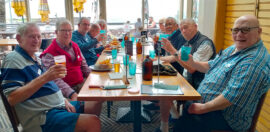Gamechangers: mental health tech on show at games week

5 October 2022 at 9:31 am
Technology pioneers are finding a way to use games to start tricky conversations around mental health.
Games can power good: that’s the message from this year’s Melbourne International Games Week.
Held from 1 to 9 October and featuring games designed to promote social impact in areas like mental health and community services, the week is a reflection of how games can touch our lives.
Pro Bono News spoke to the people behind some of the projects on show during Melbourne International Games Week to find out more about their social impact.
Biik Bilik puts community at the centre
Meaning ‘my place’ in Wurundjeri language, the Biik Bilik animated game is starting conversations on important social issues in Aboriginal communities.
Biik Bilik was born out of a partnership between Dandenong and District Aboriginal Cooperative and social enterprise the Institute of Games, which developed the Streets of My Town social impact game platform.
Streets of My Town is designed for young people and educates them about the support services available in their local community. It functions as a platform that can be tailored to different organisations and communities depending on their location and need.
Founder and CEO Steven Dupon, a social worker, wanted to find a way to appeal to young people on sensitive and tricky topics.
“We had this idea to give that information as part of the game so young people would have fun while they’re learning about some of those more challenging things that could happen in their life,” he explained.
It took around 10 years to bring the idea to fruition.
“It is really developed to get young people to… break open some conversations about things like mental health and drugs and alcohol and suicide, all those kinds of things that are difficult to talk about, and then link it to the local place.”
That link is perhaps the most important part of the game, as it targets the experience to the young person and introduces them to the solutions and supports available where they live.
“The big goal is to reduce the barriers of access, so a young person is more likely to reach out for help when they need it,” Dupon said.
Dupon is speaking about Biik Bilik at Games for Change Asia-Pacific Festival 2022 as part of Melbourne International Games Week, where attendees will hear about the social impact of games like his.
Evaluations have shown that young people love the concept behind Biik Bilik and Streets of My Town; they prefer games to more formal settings, and don’t feel judged for needing answers to their questions.
Every Streets of My Town version is co-designed with the community that will use it. In Biik Bilik’s case, it was co-designed with members of the local Aboriginal community and those with lived experience of mental health issues. It also features local landmarks, like the shopping plaza, and recognisable local people, to help users feel familiar and safe.
See more: Need a yarn? Australia’s first Indigenous-led crisis helpline is here to help
The biggest challenge in creating the game was to develop trust with the community, Dupon said.
“What often happens is that people want to work with these diverse groups without really understanding the language or the culture. And that’s why co-design is so important. And that’s why things sometimes take a long time, to develop that trust.”
There are plans in place to further develop the Streets of My Town platform so that all storylines can play out together, rather than creating different versions for different groups.
Eventually, Dupon said, he would like to be able to offer the platform to all charities and not for profits that provide services to young people, to have their service represented in the virtual world.
“That’s what the vision for the project has always been. I want this to be really accessible to anyone, anywhere.”
He said mental health and other community services should take their programs to where users are, to ensure their services are accessible for young people.
While this may go against prevailing wisdom that such conversations should be held face-to-face, he said providers need to recognise that young people want to reach out at a time and in a manner that feels appropriate for them — and that facilitating a connection is the most important thing.
“Gaming is so important to young people… it’s just where they feel comfortable. Having worked in the sector for my whole life, I think we have to push ourselves to be on these kinds of platforms where young people are, and not just expect them to come to us,” Dupon said.
“This project is just an example, I think, of how you can do that and how you can really represent your service [and] your programs to young people in a very youth-friendly way.”
Getting creative on mental health
Jill Bennett, founding director and co-director of The Big Anxiety Naarm, is always looking for new, creative ways to use technology to transform mental health.
“A lot of people with particular mental health needs or people who are traumatised, anxious, or depressed, don’t have access to adequate mental health services. And clinical services are quite limited. So we’re really thinking about how we can think about resourcing mental health in a totally different way by embedding resources in communities, but in a form that people want to engage with,” she explained.
“Can we design something that is fun and that people would want to do in their spare time?”
Bennett said the mental health sector has long had difficulties connecting with people known to be struggling with their mental health. COVID and climate-related disasters have only intensified the mental health crisis.
But there is also a desperate need to think differently about mental health, Bennett explained.
“The need to actually rethink mental health is not about necessarily saying people have a disorder and there’s a prescription that is going to put it right; it’s thinking about things we can do and engage with that can address this distress.”
The Big Anxiety is a mental health art festival that’s been running in a number of towns and cities around Australia since 2017. Increasingly, it’s running a lot of VR and AR activities.
In 2019, The Big Anxiety developed the world’s first VR environment for suicide prevention, in conjunction with young men who had a history of suicidal thoughts or attempts.
The young men made the point that they didn’t want to sit around talking about their feelings, so instead, they designed something that would shift those feelings, lift their mood and address their feelings of hopelessness.
Called Edge of the Present, the VR environment changes as its users interact with their surroundings, providing beautiful, scenic rewards for small actions.
“We started measuring what actually happened and we saw that after a seven minute engagement, people’s mood improves significantly,” Bennett said.
Senses of hopelessness also decreased significantly.
Since its creation the project has been used in different parts of the country amongst people with a history of severe depression, with similar positive results.
Now, Bennett said, the creators are exploring how they could utilise the VR environment in areas like workplaces to help reduce symptoms of mental ill health.
What makes these sorts of projects so good is that they’re easily accessible and usable by people of all ages and abilities, Bennett added.
At Melbourne International Games Week, The Big Anxiety is putting on a creative media showcase demonstrating a range of creative media projects in mental health and wellbeing.
One of those is Waumananyi, a partnership between The Big Anxiety and NPY Women’s Council. It’s an Anangu-led response to the experiences of constraint, entrapment, and depression through the traditional story (or ‘tjukurpa’) of ‘The Man in the Log’.
It uses images taken on country and videos of members of remote Aboriginal communities to tell the story and engage with mental health issues.
“We try to draw people in with things that are just immediately accessible and they’re just about play, in the first instance, even though they often have a lot of therapeutic… benefits embedded in them,” Bennett explained.
Games provide an “amazing capacity for visualisation and, and making change,” she added.
“Virtual reality gaming in particular is a big gamechanger that’s really only being used in limited ways in mental health at the moment.
“There’s always something you can do that enables people to tell their story or just be creative and engage in play that has some benefit that suits their needs. And it doesn’t always have to be led by words. I think that’s the key thing.”
If this story has raised any issues for you, please contact:
13YARN on 13 92 76
Beyond Blue on 1300 22 4636
Lifeline on 13 11 14







